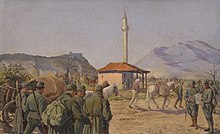Alexander Pavlovitz
Alexander Pawlowitz (born May 17, 1884 in Vienna ; † May 5, 1964 there ) was an Austrian portrait , landscape and war painter .
life and work
Fin de siècle
Born as Alexander Stebetak in Wien-Landstrasse , he adopted the name of his stepfather Wenzel Pawlowitz in 1885. Since artistic talent was already noticeable in childhood, Pawlowitz was able to study at the Vienna Academy of Fine Arts (1902–1907), where he was a student of Christian Griepenkerl , among others . From 1908 he gave drawing lessons at the secondary school in the Vereinsgasse , and with a few interruptions he was to keep this post until 1922. On September 26, 1911, he married Rella Zappler and moved into a joint home with her on Valeristraße. In 1912, Pawlowitz was commissioned by the White Cross Society to paint a life-size portrait of the heir to the throne, Franz Ferdinand of Austria-Este, for the ballroom of the newly built kuk officers' spa in Franzensbad . The completion of this portrait was recognized by the media, so that Pawlowitz was able to enjoy further commissions from church and aristocratic circles in Vienna. He was commissioned to record the World Eucharistic Congress in Vienna in 1912 in a large painting, which is now in the collections of the Archbishop's Cathedral and Diocesan Museum in Vienna. Since this painting was also recognized in the daily press and also by Emperor Franz Joseph , his reputation as a portrait painter in Vienna was consolidated.
War painter in the First World War
When the First World War broke out , Pawlowitz did not receive a draft order for the Austro-Hungarian Army due to his age and even held a Christmas exhibition of his works in November 1914. Due to the high losses suffered by Austria-Hungary in the first year of the war, at the beginning of 1915 Pawlowitz also had the option of being drafted into military service. So he tried to be accepted as a war painter in the art group of the kuk war press quarter , which was approved on December 27, 1915. His first trip as a war painter took Pawlowitz to Cattaro , where he documented the campaign against Montenegro in drawings. After the defeat of Montenegro, the campaign of the Austro-Hungarian Army continued immediately to Albania , whereby Pawlowitz came to Skutari at the end of January 1916 . As the war continued, he drew and painted on the Eastern Front, especially in the Buschatsch area , where Pawlowitz documented the consequences of the war both for the infrastructure and for the Jewish population. He also came under enemy fire on several occasions. In November 1916, Pawlowitz fell ill with typhus and spent several months in various garrison and field hospitals. After his recovery in the summer of 1917, he worked artistically on the front in Fürstenthal ( Bukowina ). After the peace of bread that was concluded in February 1918 , Pawlowitz also took part in the Austro-Hungarian advance to Odessa ( Operation Faustschlag ). Pawlowitz made the last drawings as a war painter in Chernivtsi in September 1918 . Numerous works from his time as a war painter are now in the collections of the Army History Museum in Vienna.
post war period
The artistic work of Alexander Pawlowitz after the First World War is only sketchily documented. In 1921 he moved to a studio in Vienna-Döbling , the following year he traveled to Romania for three years , where he worked as a portrait painter for the local royal family. In 1924/25 he taught at the Romanian Academy for Decorative Arts as a professor for nude, head and figurative drawing. In 1926 Pawlowitz returned to Vienna, where he worked as a landscape painter with motifs from the Vienna area until his death. He was also active as a portrait painter, as paintings from this period repeatedly appear in art auctions, especially at the Dorotheum in Vienna .
Works (excerpt)
- Camp in Skadar , Albania . 1916, oil on cardboard, approx. 50 × 90 cm, Heeresgeschichtliches Museum , Vienna
- Cossacks and Russian infantry expel Jews from the destroyed village of Buczacz , 1914, oil on canvas, Heeresgeschichtliches Museum, Vienna
- The Eucharistic Congress in Vienna , 1912, oil on canvas, Cathedral Museum Vienna
literature
- Walter F. Kalina: The everyday life of the war painter Alexander Pawlowitz , in: Viribus Untitis. Annual report of the Army History Museum 2016 , Vienna 2017, ISBN 978-3-902551-75-7 , pp. 9-27; online in the HGM knowledge blog
- Heinrich Fuchs: The Austrian painters born in 1881-1900 , Vienna 1977, Volume 2, P. K 37.
Individual evidence
- ↑ Walter Reichel: "Press work is propaganda work" - Media Administration 1914-1918: The War Press Quarter (KPQ) . Communications from the Austrian State Archives (MÖStA), special volume 13, Studienverlag, Vienna 2016, ISBN 978-3-7065-5582-1 , p. 183.
- ^ Heinrich Fuchs: The Austrian painters born in 1881-1900 , Vienna 1977, Volume 2, p. K 37
| personal data | |
|---|---|
| SURNAME | Pavlovitz, Alexander |
| BRIEF DESCRIPTION | Austrian painter |
| DATE OF BIRTH | May 17, 1884 |
| PLACE OF BIRTH | Vienna |
| DATE OF DEATH | 5th May 1964 |
| Place of death | Vienna |
